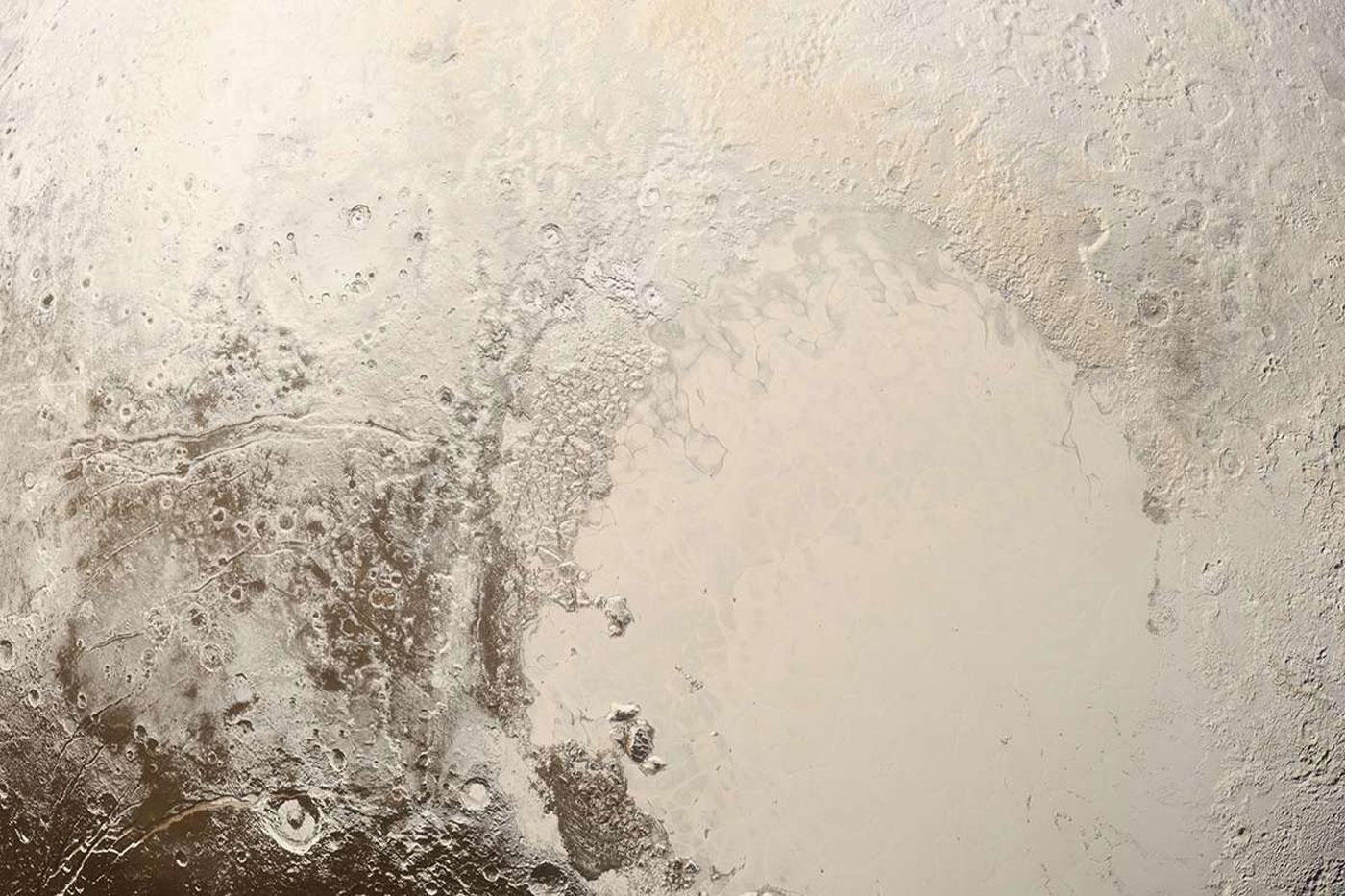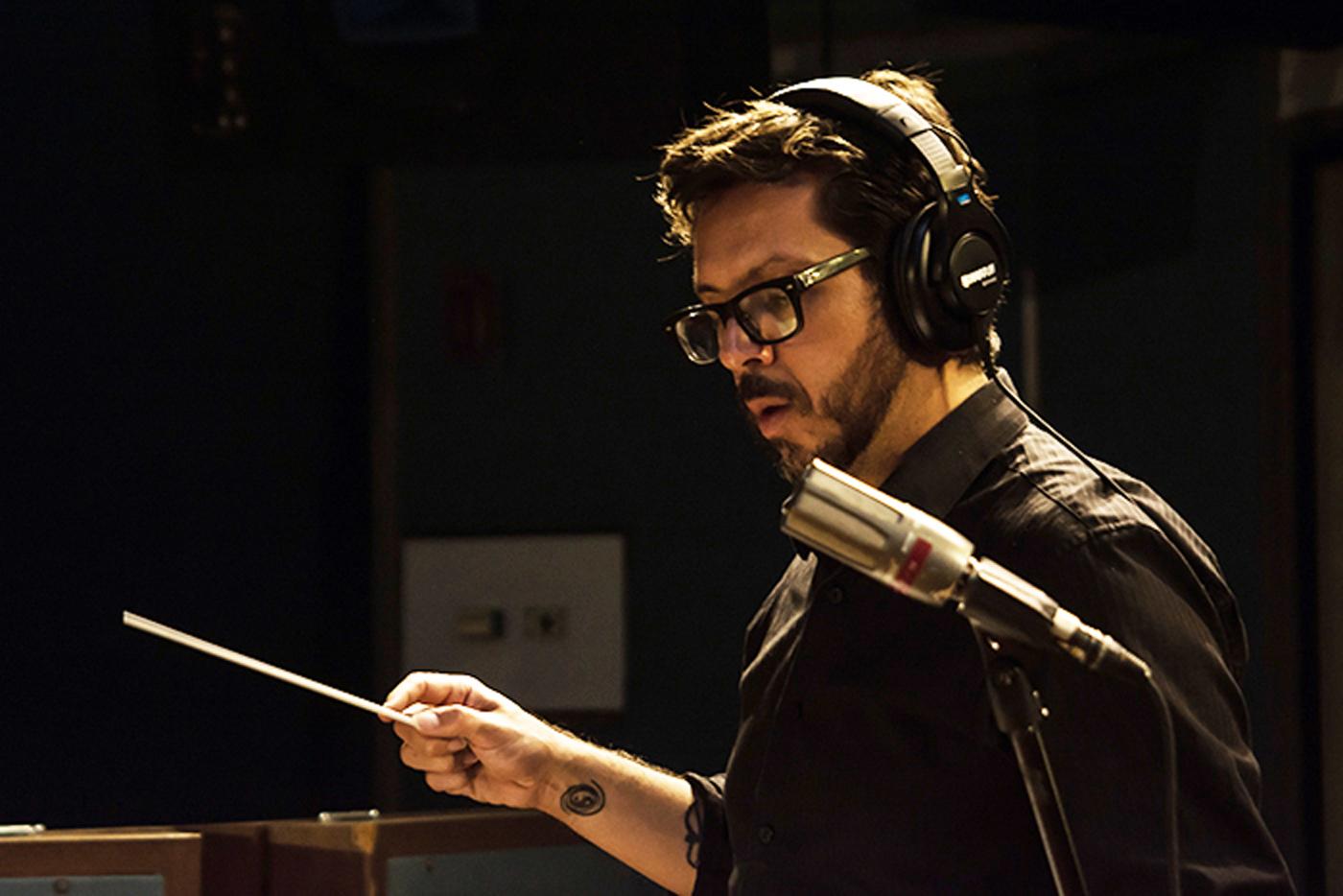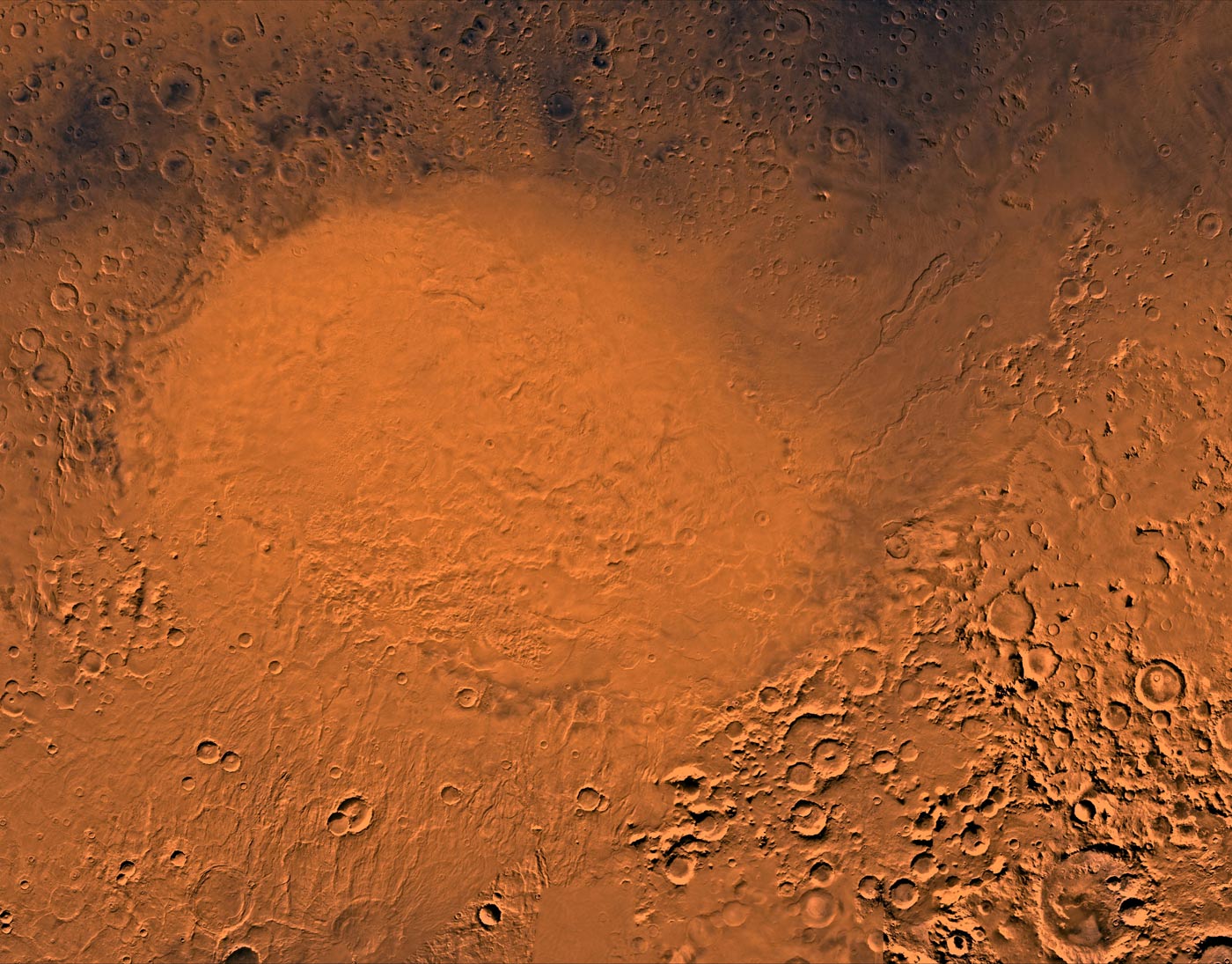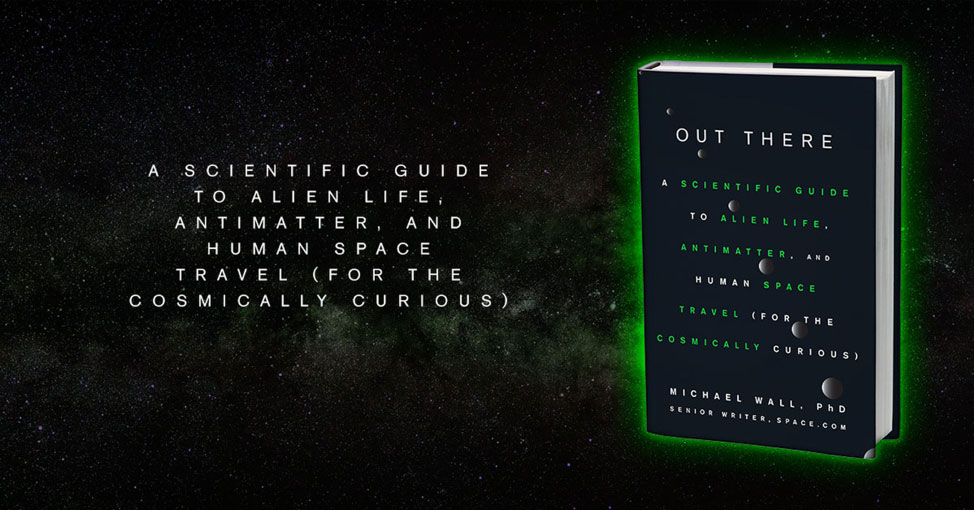
Strange formations of ice on the planet Pluto are the focus of a recent letter published in the journal Nature Astronomy. SETI Institute scientist Oliver White, lead author, describes the terrain features as “among the most enigmatic landforms yet seen on Pluto”. Parallel ridges (described as “washboard” and “fluted” terrains) were captured in images from the New Horizons spacecraft when it flew by in 2015, and researchers have been trying to investigate their origin. White’s research aims to use mapping and measuring of landforms to work out the origin of these unique structures that haven’t yet been seen anywhere else in our Solar System. White and scientists from NASA’s Ames Research Center found that the formations may be remnants of an “ancient glaciation” period in Pluto’s ancient past. White explained in an article on New Scientist:
“A chunk of water ice would bob around until it reaches the wall of one of these pits, and it would slide down,” says White. “Eventually the nitrogen ice would sublimate away, so the water ice material filling the pits would be left behind, draped across the landscape.”
There is still much about Pluto’s terrain that remains mysterious.
- New Scientist: Pluto’s weird ridges may be glacial landforms unlike any on Earth
- Inquisitr: Pluto Has ‘Enigmatic’ Features Unlike Anything We’ve Ever Seen
- Labroots: Was Pluto Once Home to Ancient Glaciers?
- Daily Mail: Mysterious 'washboard' and 'fluted' ridges on Pluto prove the dwarf planet was home to frozen GLACIERS of nitrogen four billion years ago
- SETI.org: Washboard and Fluted Terrains On Pluto as Evidence for Ancient Glaciation
- Nature Astronomy: Washboard and fluted terrains on Pluto as evidence for ancient glaciation
 Airborne Astronomy Ambassadors – Bringing Educators above the Clouds in SOFIA
Airborne Astronomy Ambassadors – Bringing Educators above the Clouds in SOFIASOFIA, which stands for Stratospheric Observatory for Infrared Astronomy, is a modified Boeing 747 equipped with a telescope, and is the largest airborne observatory in the world. SOFIA flies into the stratosphere to get above the water vapor than hampers visibility, allowing scientists to study the universe by collecting images in infrared light. Thanks to a partnership between the SETI Institute and NASA, teachers can experience the thrill of conducting research on this advanced craft, through a program called Airborne Astronomy Ambassadors (AAA). The AAA program helps with the professional development of teachers, equips them to inspire a love of science in their students, and is designed to enhance student STEM achievement and engagement. Local news KSEE24 did a four-part feature on SOFIA that included interviews with three teachers from California’s Central Valley who had the opportunity to fly.
Past years have invited teachers from California school districts, but future groups will be selected from districts across the nation. You can find out more about the AAA program on our website, SETI.org.
- KSEE24 Eyewitness News: NASA’s SOFIA: Central Valley Teachers Ride on World’s Largest Airborne Observatory
- SETI.org: Airborne Astronomy Ambassadors
 The Sound of Science
The Sound of ScienceNew Sounds, a “daily showcase of weird and wonderful music,” presented an episode on The Sound of Science, a project featuring music inspired by science. Composers created pieces inspired by the life and work of scientists in various fields. One work, “Quest”, was inspired by the life and work of Jill Tarter, who is Chair Emeritus for SETI Research and cofounder of the SETI Institute. The piece was written by SETI artist-in-residence Felipe Perez Santiago, who is the newest artist to join the SETI AIR program and is currently also working with Tarter on a musical project called Earthling.
The piece features the cello interwoven with the sounds radio signal recordings provided by Tarter. Listen to a musical interpretation of Tarter’s lifelong endeavor to search for life in the universe (it’s about 41 minutes into the episode), then head over to SETI.org to learn more about Santiago and the SETI AIR program.
- New Sounds: Music Inspired by the Sciences
- SETI.org: SETI Artists-in-Residence Felipe Pérez Santiago to Perform at Montalvo Arts Center
- SETI.org: The SETI Institute’s Artists in Residence Program
 Ephemeral Lakes of Mars
Ephemeral Lakes of MarsResearchers have released a new study revealing further evidence that Mars once had flowing water on its surface. Virginia Gulick, SETI Institute senior research scientist and one of the co-authors, found data indicating a number of ancient lakes and water drainage systems across a surprisingly long time-span. Gulick described the research in Astronomy Magazine:
“We were finding that these channels were active periodically through Mars’ history and much more recently than previously thought. They were active periodically from the late Noachian through the Hesperian through the late Amazonian,” Gulick said. Those time periods span billions of years, reaching to very near the present day, and indicate that such hydrological features were a common and long-lasting on the martian surface.
This research could be important in the search for life, potentially providing evidence for past microbial life on the planet. “Areas where water was periodically available over long periods of Mars' history, especially if they were associated with volcanic magma hydrothermal systems, could have provided the habitats suitable for microbial life if it ever arose,” Gulick said.
The research could have considerable impact on the search for life beyond Earth.
- Astronomy Magazine: Temporary lakes once filled and refilled across Mars’ surface
- SETI.org: Groundwater and Precipitation Provided Water to Form Lakes along the Northern Rim of Hellas Basin throughout Mars’s History
- Astrobiology: Paleolakes of Northeast Hellas: Precipitation, Groundwater-Fed, and Fluvial Lakes in the Navua–Hadriacus–Ausonia Region, Mars
 Jill Tarter in New Book: OUT THERE
Jill Tarter in New Book: OUT THEREA newly released book, "OUT THERE: A Scientific Guide to Alien Life, Antimatter, and Human Space Travel (for the Cosmically Curious), by science writer Mike Wall, looks into the search for extraterrestrial life. Jill Tarter, cofounder of the SETI Institute and Chair Emeritus for SETI Research, is featured in the book, quoted in an excerpt published on LiveScience:
"There's a lot of real estate out there, and we now know that," said radio astronomer Jill Tarter, who co-founded the SETI Institute in Mountain View, California, and served as the inspiration for Ellie Arroway, the lead character in Carl Sagan's novel Contact and the movie based on it.
The book examines what we now know about that “real estate”, as well as the implications of finding a signal… or not. As Tarter points out, finding a signal from another technological species could say a lot about humanity’s chance at survival:
"The detection of a signal—even a cosmic dial tone, with no information — goes on to tell us that we can have a long future," Tarter said. "If somebody else made it through, we can, too."
- LiveScience: Where Are All the Aliens? 'Out There' Book Excerpt
 Under One Sky
Under One SkySeveral years ago, former astronaut Mae Jemison had a discussion with SETI Institute cofounder and Chair Emeritus for SETI Research, Jill Tarter, and actor LeVar Burton, which brought an idea into being:
That pivotal conversation involving Jemison, Burton and Tarter centered on how to connect people to space.
"We were really working very hard on that," Jemison recalled, "so we actually thought that in some kind of way we have to get back to folks thinking about the world as connected. And in fact, Jill talked about the fact that if we don't consider ourselves as 'Earthlings' ... that's a major concern. All the work that I've ever done, since I've come out of NASA, is really about 'how do we connect with each other on this planet?'"
That conversation led to Look Up.
The project invites people to take “Skyfies” and post them on the Look Up website to create a global tapestry, allowing people from all over the world to see what others see when we behold our shared sky. Tarter has in fact encouraged people to identify as Earthlings on social media, as she recently told the Harvard Gazette:
I usually send people home from a lecture with a homework assignment, which is to go and alter their profiles on all of their social media so that the first thing they say about themselves is that they are an Earthling, because I think that this is the kind of perspective we are going to need to figure out how to solve all these really difficult challenges we have that don’t respect national boundaries. We’ve got to do it in a systemic global way, and I think the first step to getting there is to see ourselves in that context.
When is the last time you looked up?
- TechNewsWorld: Star Explorer Mae Jemison: The Sky Connects Us
 Talking to Machines
Talking to MachinesWhat if first contact looks less like meeting interstellar visitors, and more like meeting their artificial technology? Communication with an extraterrestrial species might be a head-scratcher in itself, but as an article for How Stuff Works points out, communicating with an alien machine may be harder still. Seth Shostak, Senior Astronomer at the SETI Institute, isn’t worried though:
"If you just said lots of things," he explains, "and no matter what is at the other end, if it's an intelligent machine, then it can certainly go through all that information and pick out the redundancies. Even if it's little gray guys with big eyeballs, they probably have some big computers and so they could do the same thing with their computers."
Shostak argues that while it’s very unlikely to be found by extraterrestrial beings or their AI, equipping an abundance of information in future probes would allow a sufficiently advanced program to learn our communication protocols, certainly enough to allow them to recognize contact.
 Leaving the Light On for E.T.
Leaving the Light On for E.T.MIT researchers have proposed that it’s possible to craft a laser-powered “porch light” with current technology, in order to alert to distant advanced civilization to our presence. The idea is to create a beam of light that would shine brighter than our sun even when seen from light-years away. This has led to a fair bit of debate as to the safety of doing so, as the SETI Institute’s Senior Astronomer, Seth Shostak, explained in an article for NBC News MACH:
Mind you, not everyone is enthusiastic about constructing a bright beacon that tells others we’re home. It might just provoke hostile action by peevish extraterrestrials.
On the other hand, this has led to unavoidable speculation that extraterrestrials with comparative technology could do the same:
But even if we decide against putting a marker light on Earth, it’s possible that other, less paranoid galactic societies have done so. And it’s a simple experiment to search for the type of modified star shine such technology would produce.
Obviously, we should be looking. Maybe someone has left the light on for us.
Big Picture Science
In last week’s episode, the team visited the Science Denial symposium in New York to find out what drives public resistance to scientific findings, in Skeptic Check: Science Denial. On our previous week’s episode, experience the draw and the dangers of GPS in an encore presentation of Rerouting... Rerouting.
Last week on Facebook Live, SETI Institute scientist Franck Marchis spoke to Jeff Coughlin, Director of the Kepler/K2 Science Office, about the end of the Kepler and K2 Missions. Videos of all past Facebook Live events can be found on our Facebook page: https://www.facebook.com/SETIInstitute/
- NewSpace Europe: Breaking Barriers: November 27-28, Luxembourg City, Luxembourg The SETI Institute is a sponsor of this event.
- 2018 California Science Education Conference: November 30-December 2, Pasadena, CA Pamela Harman, Acting Director of the Center for Education at the SETI Institute will offer two workshops
- American Geophysical Union (AGU) Fall Meeting: December 10-14, Washington, D.C. Several SETI Institute scientists will be participating
- 223rd Meeting of the American Astronomical Society (AAS): January 6-10, 2019 Seattle, WA Several SETI Institute scientists will be participating





